The Occupational Safety and Health Administration (OSHA) has decided to put off for another year
enforcement of some of its hearing and ergonomics reporting requirements. The requirements were
part of the Occupational Injury and Illness Recording and Reporting Requirements published January
19, 2001. The elements being put off until January 1, 2004, include a definition of musculosketal
disorders and requirement to maintain a log for such disorders that occur in the workplace, and a
requirement for employers to provide certain information about hearing loss. The changes were
contained in a final rule published in the December 17 Federal Register.By James A. Morrissey,
Washington Correspondent
December 2002
OSHA Delays Hearing And Ergonomics Requirements
All Wound Up
Take-Up SystemsBy Jennifer Dennard, Assistant Editor All Wound Up
Advancements in fabric take-up systems and winding technology offer enhanced quality and
reduced cost. Large fabric roll batching, introduced to the United States more than 35
years ago, often has taken a back seat to newer, flashier textile developments. Although fabric
winding machinery and take-up systems dont have many bells and whistles, they remain an important
part of a companys vertical process for some very good reasons. Take-up systems offer continuous,
longer runs, leading to less cutting and sewing, and reduced production costs and fabric waste.
Manpower is reduced because fewer transports are needed. Less handling of fabric by human hands
during manufacturing and transportation processes lowers the risk of damage and enhances
quality.Companies specializing in these often overlooked systems today strive to offer not only new
and innovative products, but also improved, often customized, winding machinery.Companies such as
Birch Brothers Southern Inc., ParksandWoolson Machine Co., Alexander Machinery Inc. (Alexco) and
Menzel are in the fabric winding and take-up system business. They know customers want faster, more
reliable winding machinery requiring even less hands-on maintenance and enabling more on-time
delivery. Customer service remains a top priority everywhere. Birch BrothersThe industry trend
is very simple, not only in the United States but worldwide quality, faster, with as much
automation and as little labor as possible, said Steven W. Birch, president, Birch Brothers
Southern Inc.The Waxhaw, N.C.-based company specializes in rewinders that cut and restart on the
fly without stopping. The company currently has 1,200 automatic winders installed in the United
States and abroad. Our new 4-Roll generation of fully automatic winders has been
well-received, said Birch. The 4-Roll Real Time Transfer Fully Automatic Winder produces rolls of
textiles, nonwovens, paper film and foil from 4 inches to 78 inches in diameter, with roll weights
up to 10,000 pounds.
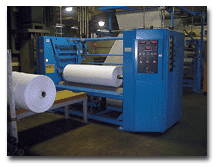
Birch Brothers’ 4-Roll Real Time Winder technology allows in-line slitting and enables
shipping from the production line. According to Birch, new take-up system products, such as
the 4-Roll Real Time Transfer Fully Automatic Winder, would not have been possible without recent
developments in take-up systems such as AC vector drive technology and readily available
programmable logic controllers (PLCs).Recent 4-Roll installations include: Copland Fabrics,
Burlington, N.C.; Springs Industries Inc., Fort Mill, S.C.; Velcro USA, Manchester, N.H.; Highland
Industries, Greensboro, N.C.; and Carpenter Co., Richmond, Va.In addition to its 4-Roll product
offering, Birch also rebuilds, retrofits and warranties as new any Birch winder using older
technology. ParksandWoolsonParksandWoolson Machine Co., Springfield, Vt., has been building
textile finishing machinery since 1826.The company concentrates on the manufacture of
custom-designed face finishing systems, such as shears, tigers, nappers, sanders/sueders and
quality systems.
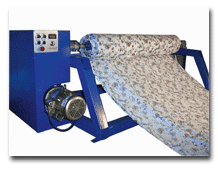
ParksandWoolson’s Posi-Winder provides speed or torque control for winding and unwinding
processes.The recently developed AC drive Posi-Winder Wind/ Unwind System continues the companys
investment in leading-edge technology. The Posi-Winder, suitable for textiles, film, nonwovens
and paper, operates as a winder or as an unwinder, and delivers web with consistent tension from
beginning to end, regardless of roll diameters. Surface speed of delivery is matched to the
operating speed of the connected equipment.[It] is simple and provides either speed or torque
control over the process, said A.G. Peterson, president.The Posi-Winders modular design allows for
rapid and easy integration into any existing web line. Electrical integration is accomplished via a
quick-connect interface cable.This single platform replaces the need for different winders for
specific application types surface winding versus center winding, said Joseph M. Gardner, vice
president.Gardner also mentioned the evolution and reliability of AC drive system technology, such
as that used by the Posi-Winder. As of late, AC drive systems have evolved at an extremely rapid
pace. Perhaps more important is the fact that the technology has matured to the point that it is no
longer cutting-edge technology, but proven technology. It is critical that we field designs that
are proven to be reliable (hardware and firmware) and supportable from a logistics standpoint
globally, Gardner said.ParksandWoolson platforms are designed around ABB AC drive systems, which
are more cost-effective when compared with DC drives or hydraulic systems, according to the
company.The AC drive system has resident firmware that automatically, without any additional roll
diameter sensors, calculates roll diameter buildup and compensates in torque and speed mode, thus
providing specific or tensionless winding and unwinding, Gardner explained. This capability allows
us to offer a low-cost (acquisition and lifecycle) platform that emulates both center and surface
winders and unwinders a single solution for any web winding and unwinding
requirement.ParksandWoolson provides equipment maintenance, repair and technical support for its
machines. We can modify or adapt virtually any system to our Posi-Winder design, Gardner said. We
also can provide custom-designed systems to meet any unique needs of our
customers. AlexcoAlexander Machinery Inc. (Alexco), Mauldin, S.C., has taken part in the trend
towards more maintenance-free take-up systems. There has been great improvement in Alexco take-up
drive systems, which eliminate moving parts, said Jeff Davis, vice president, sales.Recent
offerings from Alexco include a center-wind off-loom take-up for technical and specialty fabrics.
The company also offers the Fabricmaster large-roll center-wind take-up for fiberglass or carbon
fiber fabrics. Alexcos large-roll off-loom take-ups feature structurally sound heavy steel
end-housings to enclose drive components, as well as Power Doff to move fabric rolls from take-up
to transport vehicle. Systems are low-maintenance and have low power consumption, according to the
company. They are available with center-wind and surface-wind function. Fabric oscillators also are
available. Alexco take-ups are available for all types of fabrics, as well as for all types of
fabric-forming machinery.
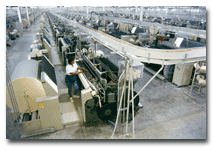
Alexco’s fabric take-up systems are installed at Avondale Mills Inc.’s Horse Creek
Plant. Customization is a large part of Alexcos business. Alexco has always maintained a
strong engineering department. The advantage Alexco has over other suppliers is that we can
custom-design a system for particular or specialized applications, Davis said. Alexco offers
customized take-up and inspection arrangements, as well as refurbishing services for older machines
for installation on new weaving machines. MenzelMenzel, Spartanburg, introduced the first
large-roll batching system to the US textile industry in 1965. It continually has focused on
innovations in web handling and finishing equipment.Today, Menzel manufactures a standard line of
take-up systems and custom-designed systems to comply with customer requirements.Currently, Menzel
offers the Turret Unwinder or Winder, a two-position turret winding system that reduces downtime
and enables quicker roll changes by allowing simultaneous winding and unloading.
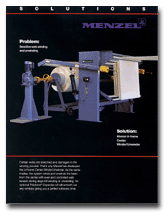
Menzel’s product line includes theA-frame center winder/unwinder.A variety of other surface
winders also is available, including the Electric A-Frame Surface Winder; Two-Roll Surface Winder;
and Two-Roll, Low Profile Surface Winder.The Menzel 3-Roll fully-automatic, computer-controlled
winder enables production lines to continue to run while finished rolls are being doffed on the
fly. An A-Frame Center Winder/Unwinder and a Multi-Station A-Frame Winder are also part of the
Menzel product line. Menzel offers refurbishing services for its older take-up systems as
well.According to Jack Wingo, sales manager, computer-controlled systems, such as the 3-Roll
Automatic Winder, are part of a trend to provide more precise control and improved roll
quality.Developments ContinueTake-up systems have come a long way over the last 35 years. With
advancements in full automation, the elimination of moving parts and mechanical control systems, as
well as lower maintenance, the textile industry is seeing faster, higher-quality take-up systems
continue to develop.
December 2002
Singapore Pact Pleases Textile Industry
The nearly-completed US/Singapore free trade agreement appears to have incorporated most of the
wish list of the US textile industry. While final details still need to be worked out, and the
agreement signed by the respective governments, initial reports indicate the agreement has a tight
country of origin requirement and includes perhaps the toughest Customs enforcement of any free
trade agreement. Since Singapore is not a major player in textile trade, the basic appeal of the
agreement involves other industries where some $33 billion in trade takes place at the present
time.The significance of the pact, where textiles are concerned, is that it may set a precedent for
future trade agreements involving other Asian nations where textiles are much more of a factor.
From the time the free trade agreement was proposed by President Bill Clinton, the American Textile
Manufacturers Institute (ATMI) and its supporters in Congress pressed for a NAFTA-like country of
origin rule and, since Singapore has little textile production, strong measures to prevent
transshipments from other countries. The rule of origin generally requires that goods be made from
yarn and fabric from either of the participating countries in order to qualify for duty and
tariff-free treatment. Since Singapore has little textile production, that means US-made products.
As a result of that rule, importers see little value in the agreement because of the time and
distance involved in using US yarn and fabric. Something that appeals to importers is agreement to
permit 25 million square meters of fabric made in other countries to be imported with the
preferential treatment, but that level of that trade will be phased out gradually over five
years.For the first time under a free trade agreement, all textile and apparel factories in
Singapore that ship goods to the United States will be required to register and provide information
about their production capabilities to both governments.In announcing the agreement, US Trade
Representative Robert Zoellick indicated that the Singapore pact, which still is subject to
approval by Congress, could provide a framework for future agreements.By James A. Morrissey,
Washington Correspondent
December 2002
Hubtex Introduces Carousel Storage Truck
 Hubtex IntroducesCarousel Storage TruckSpartanburg-based Hubtex of North America Inc. now offers a mobile carousel storage truck for use in the cut-and-sew industry. The truck, which stores a minimum of six rolls up to 163 inches long with diameters up to 24 inches and weights up to 880 pounds each, can be positioned directly behind a cutting table. Capacity can be increased for smaller-diameter rolls by adjustment of the roll supports. Fabric is fed onto the table without necessitating manual handling or removing the roll from the truck.Hubtex also offers stationary units that can be permanently mounted behind the cutting table. These units have standard capacities of eight to 25 rolls. They also can be custom-designed with unlimited capacity. December 2002
Hubtex IntroducesCarousel Storage TruckSpartanburg-based Hubtex of North America Inc. now offers a mobile carousel storage truck for use in the cut-and-sew industry. The truck, which stores a minimum of six rolls up to 163 inches long with diameters up to 24 inches and weights up to 880 pounds each, can be positioned directly behind a cutting table. Capacity can be increased for smaller-diameter rolls by adjustment of the roll supports. Fabric is fed onto the table without necessitating manual handling or removing the roll from the truck.Hubtex also offers stationary units that can be permanently mounted behind the cutting table. These units have standard capacities of eight to 25 rolls. They also can be custom-designed with unlimited capacity. December 2002
Scholl Then Agree To Merge
Scholl, Then Agree To MergeSwitzerland-based Scholl Switzerland AG and Then GmbH, Germany, are to merge effective January 1, 2003. The new company will be called Scholl-Then AG and will be headquartered in Safenwil, Switzerland. Then will own 70 percent of the new business. Scholl will own 30 percent. Scholl-Then will manufacture its wet processing machinery and dispensing and dissolving equipment in Safenwil and Schwaebisch-Hall, Thens present location.December 2002
Datacolor Launches Mercury 3000
Datacolor Launches Mercury 3000The Mercury 3000 Color Measurement System is the latest development in Lawrenceville, N.J.-based Datacolors Mercury series of portable spectrophotometers. The series, which also includes Mercury 1000 and 2000, was designed to provide bench-top precision and easy navigation using Personal Digital Assistant (PDA) touch screen technology.The top-level Mercury 3000 features ultraviolet (UV) calibration for whiteness measurement of samples containing fluorescent whitening agents. The system also calculates Ganz and CIE whiteness indices, selects standards automatically and can store more than 30,000 samples. Options include fixed UV excluded capability, holders for irregular samples, a fixed bench stand and extra battery packs.All Mercury models are compatible with other Datacolor software, including ColorTools QC.December 2002
Streamlining Color Management
Supply Chain Management
TW Special Report Streamlining Color Management
Sara Lee, National Textiles work to deliver quality and on-target color quickly,
cost-effectively and electronically. The process of ensuring that the color a designer
picks is an exact match to the finished garment is one of the more complex aspects of apparel
manufacturing. Leading manufacturers and suppliers throughout the apparel supply chain are
implementing new and better technologies to streamline the color cycle. Consider the supplier
portion represented by Winston-Salem, N.C.-based Sara Lee Branded Apparel, and one of its
suppliers, National Textiles LLC, also in Winston-Salem. National Textiles fabric goes into such
well-known Sara Lee brands as Champion, Hanes, Hanes Beefy-Ts, Hanes Her Way and Just My
Size. Color CommunicationIn 1999, Wal-Mart, one of Sara Lees major retail customers, began
exploring the possibilities of electronic color communication. Wal-Mart chose a color communication
system developed by leading color technology provider Lawrenceville, N.J.-based Datacolor. Through
Datacolors Color Information Management System (CIMS), every aspect of the supply chain has the
capability to share electronically precise reproduction, analysis, manipulation, and communication
of color data and images. The system utilizes familiar tools such as color measuring instruments
and color management software, as well as innovative elements such as calibrated computer monitors
and accurate visualization of digital color information.Both Sara Lee Branded Apparel and National
Textiles agreed to participate in a pilot project. Our company has a strong history of building
relationships with our customers, suppliers and other business partners to provide the high
quality, high value products consumers demand, stated Scott Crump, Sara Lees director of quality
resources.National Textiles President Jerry Rowland and Vice President of Textile Manufacturing
Gene McBride shared this philosophy as well, and were open to integrating new technology into their
operations. E-Dips: The First PhaseAccording to Luke Roland, color development lab manager at
National Textiles, while the heavy volume in the color lab made it a perfect place to start testing
the efficacy of the new system, there was initial skepticism.
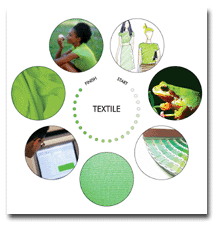
Learning any technology represents a tremendous learning curve and many highly experienced
color technicians, those highly knowledgeable in the art of color development, have their doubts.
But, when all is said and done, there just arent enough of those color masters around to keep up
with demand. New electronic color channels offer a method of capturing that knowledge and making it
available in a totally non-subjective manner, Roland stated.Approximately one year ago, National
Textiles began electronically submitting its lab dips. The process virtually eliminated physical
samples and the challenges inherent with any physical sampling process. Physical standards, for
example, are often on a different fabric from that to be dyed in production. The standard may be
physically small, making it difficult to handle or measure. The characteristics of physical
standards printed on paper may cause flaring in certain lighting. And physical swatches
susceptibility to light, heat and humidity can change a fabrics color substantially. Plus, there
can be distribution delays in moving physical samples from one location to another in order to
create a physical standard for each plant.Suppliers regularly need several dye plants to produce
the same color. Using the same electronic standard loaded by central color development allows each
one to dye to an identical target. The end result is a uniform color and better test
results.Independent testing lab Consumer Testing Laboratories (CTL) is able to evaluate e-Dips both
numerically and visually. The numerical assessment of color difference and pass/fail are based upon
standardized color practices. Visual assessment of e-Dips is possible through precise monitor
calibration and imaging an integral part of the CIMS color management solution. The use of e-Dips
in the color development process shared between Sara Lee and National Textiles has led to
significant reductions in the development cycle. Now we can submit a lab dip to CTL electronically
and receive a response in less than 24 hours, said Bill Poore, manager, color development, dyes and
chemicals, National Textiles. Instant e-mail also eliminates shipping costs. This kind of reduced
development cycle, in turn, significantly improved resource utilization at all key points at both
companies, considering the number of new colors each season and the number of lab submits that must
be evaluated. At the manufacturing level, National Textiles color lab matches more than a thousand
new colors per year, often encompassing three to five seasons.And the in-house skeptics Theres just
no arguing with results, Roland said. Now, when the customer sends us an electronic standard, we
can be absolutely sure that we have the exact standard, no question. That fact alone has saved us
enormous time and effort in response and approval times. Electronic Shade BandsEarlier this
year, National Textiles, in full cooperation with Sara Lee, began extending the viability of
electronic standards by testing electronic shade banding. After lab dips have been approved,
examples of the production runs, or shade bands, need to be sent out for customer approval. With
multiple textile manufacturing facilities operating 24 hours a day, seven days a week, National
Textiles was constantly up against tight shade-development cycles.Although much of Sara Lees
branded consumer apparel products are basic apparel products like T-shirts, underwear, and socks
that endure over time, a significant portion of its lines changes seasonally. In every instance,
however, product development begins months before products will actually be available in the
stores, requiring retailers to predict what colors and styles will be popular. We need to be able
to satisfy our customers needs for shortened lead times while delivering a quality product, Crump
added. While final tests have not yet been completed, the company is experiencing a pass rate of
well over 90 percent. Weve already experienced remarkable efficiencies with having the bulk of our
volume shades incorporated into an electronic system. Over the coming months, we will have supplied
CTL with enough production data to develop color-specific tolerances. The goal is to begin
e-mailing shade band information directly to CTL and receive a response within the hour, Poore
said.Electronic submission of shade bands has been particularly useful for companies having
multi-locations like National Textiles and Sara Lee. National Textiles has four manufacturing
locations and a cotton distribution center located throughout the Southeast. Sara Lee has three
production facilities in the Carolinas. We are able to see the variations that are occurring from
plant to plant, and totally eliminate them before they become costly. The reduction in re-dyes and
reworks alone has been worth it. Weve been able to totally eliminate the overhead costs of sending
clerical help to and from our various facilities and to CTL with physical swatches. This money can
now be funneled into other key areas such as new product development and technology, Poore
said. Positive ConsensusSara Lee Branded Apparel and National Textiles agree that the new
electronic color communication system has improved quality overall. From the efficiencies
experienced through e-mailing digital color information to shorter development cycle times and
lower development costs, the companies have ensured unprecedented accountability at every key point
in their color development and production approval processes.Weve had outstanding success so far
with this new method, moving from trial to a fantastic turnaround time, Johnson revealed.The impact
on our decision-making process has been outstanding, Crump said. Weve always worked well with our
suppliers such as National Textiles, as well as with our major customers. Now, we have the tools to
respond to seasonal needs and really any customer request, almost real time.Perhaps Poore sums it
up best. It comes down to communication. We are building a complete color communication system that
seamlessly links and controls color, from the moment it is conceived to the time the consumer buys
it.
December 2002
NTA Presses Bush Administration To Honor Commitments
NTA Presses BushAdministration To Honor CommitmentsThe newly formed National Textile Association
(NTA), Boston, is weighing in on the issue of fair trade for U.S. textiles. At the organizations
initial annual meeting September 22, NTAs Board of Directors issued a resolution entreating the
Bush administration to fulfill each of the commitments tendered to the U.S. textile industry in
December 2001.
(See Washington Outlook, TW, January 2002.) Noting the difficulties the industry faces as
a result of trade barriers established by China, India, Pakistan, Brazil and other countries, the
resolution further calls upon Congress and the administration to deny any further liberalization of
the U.S. textile and apparel market either through legislation and/or an executive branch
decision.Formed as a result of the merger of the Northern Textile Association and the Knitted
Textile Association, NTA represents more than 200 U.S. textile producers and suppliers
(See News, TW, September 2002).
November 2002
Organic Cotton Featured In Fashion Show Ad Campaign
The Sustainable Cotton Project (SCP), Oroville, Calif., and the San Francisco-based Academy of Art
College (AAC) recently collaborated on the Organic Cotton Collaborative Project, an effort to
educate both students and consumers on organic cotton and conventional cotton cultivation.The
project included a graduate fashion show featuring new designs made using organic cotton, as well
as A Better Feeling, an advertising campaign designed by AAC students to raise consumer awareness
of the benefits of organic cotton.We feel that ecological issues will be an integral part of design
in the future, and that organic cotton is therefore a long-term trend, not a short-term fashion
fad. We have been working with the Sustainable Cotton Project for a number of years to educate our
students about conventional cotton cultivation, but this year we chose to highlight the SCPs work
and take a position with organic cotton ourselves, said Simon Ungless, assistant director for
fashion, AAC.
November 2002
International Shows Take On New York
International Shows Take On New York
European Preview opens door for global textile shows in New York City. Early in 2000,
the organizers of Premiere Vision announced they were planning to launch European Preview, a
capsule version of the Paris apparel fabric show, in New York City. Skeptics questioned their
wisdom; fabric shows in New York had never worked. Held twice a year and now in its fifth
season, not only is European Preview a tremendous success, but it has spawned four other shows, all
happening at the same time. The last European Preview featured lines from 150 exhibitors from nine
European countries. More than 3,000 visitors attended the most recent show, looking for new fabrics
and new resources for the Fall 2003/Winter 2004 season.
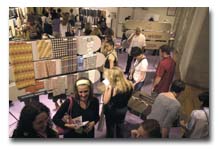
More than 3,000 visitors attended the most recent European Preview show, held in July in New
York City. A year after European Preview came to New York, the first I-TexStyle show took
place. It is a joint venture of the Italian Trade Commission, MAGIC International, PratoTrade and
Sistema Moda Italia. All of the 107 exhibitors were Italian.A season ago, Turkish fabric companies
initiated the Turkish Fashion Fabric Exhibition (TFFE), featuring lines from fabric and trim
exporters. It has been organized by Istanbul Textile and Apparel Exporters Association (ITKIB).Also
picking up on the popularity of European Preview, Tencel Inc. presented fabrics from 16 Asian
customers at Innovation Asia. Not to be outdone, Austria-based Lenzing AG hosted Asian Source, an
event for a group of 14 Korean fabric companies. European PreviewThe success of European
Preview is due in part to organization, selectivity and innovation. The organizers are a
not-for-profit group with the single goal of producing a good show. A lot goes into presentation to
give the show a unified look and to aid buyers in locating fabrics and resources. A display of
exhibitors fabrics at the entrance, culled and organized into trends, gives buyers a first look at
the new season.Exhibitors are carefully screened and selected by a peer group. Standards include
quality, creativity and service. One requirement is that the exhibitors show at a major European
textile show. According to Daniel Faure, president of Premiere Vision and European Preview, there
is a waiting list to exhibit at European Preview. Most of our exhibitors have been showing since
the inception there is very little turnover. We did acquire a few spaces when some of our Italian
exhibitors dropped out to go with I-TexStyle, he said.Another requirement is that each exhibitor
must have the ability to service the American market, either via an office in the United States, a
reputable agent or the ability to follow through from its home country.The show is organized by
fabric categories. All of the shirting fabrics are in one area. There are separate sections for
wool, silk, linen, sportswear, denim and corduroy, knits, printed fabrics and laces.Italian mills
still have a major presence at European Preview, with about 35 exhibitors. Many represent the top
end of Italian textiles, such as silk weaver Mantero Seta; Loro Piana and Lanificio Luigi Botto
S.p.A., both woolen producers; Marioboselli Jersey S.p.A. and Jackytex S.p.A. in knitted fabrics;
Crespi I.F.T. S.r.l. in the linen sector; and prints from Miroglio S.p.A. and Cantoni Satilai
S.p.A.Mark Templeton, who handles menswear buying, designing and product development for the Orvis
catalog, commented on the Italian cottons with water-repellent finishes, and Scottish tartans and
twills. We did very well with kilts in our Christmas catalog. Im looking at new patterns and
textures, Templeton said.Pamela Choy, vice president, merchandising and product development, DKNY
City, liked the lightweight textured fabrics at Riopele-Niki Bosch Design, a Portugal-based company
noted for high-tech fabrics. Crinkles and stretch were of special interest.According to Peter
Ackroyd, director, National Wool Textile Export Corp., United Kingdom, there was a 45-percent
increase in visitors to the show the first day. Most of the UK exhibitors fell into the woolen
sector. Here, texture was a strong look. It ran the gamut from Shetland and Donegal tweeds to wool
seersuckers, burn-outs, dobbies and waffle weaves. Washable worsted wool twill suitings and
lighter-weight fabrics also were of note. The most popular colors were somewhat subdued with a
slightly aged look.Sheila Marks of Bill Blass commented on texture: There is so much innovation,
mixing fibers and colors to create novel textures and patterns. Fall 2003 will be a very exciting
season.In the wool sector, a new development is the blend of wool/cotton. Ottavio Crotti S.r.l.,
Italy, showed cashmere/cotton blends in jacket weights. At Ireland-based Ulster Weavers, there were
burn-outs in this blend. Carreman of France presented structured, rustic twills and
herringbones.Knitted fabrics from Austria, France, Germany, Italy, Spain and Switzerland also were
shown. Texture reigns here too, with raised patterns, dimensional effects, lacy knits and embossing
on suede.In sportswear, denim is king. There are a lot of new blends and application treatments,
including metallic patterns, flocking and plastic coating that resembles sequins. Crinkled and
pleated surfaces are another strong trend.There were 17 companies in the printed fabric category.
Romantic florals, paisleys, foulards and patchworks were shown in almost every
line.Weisbrod-Zuerrer AG, Switzerland, showed padded layers combining satin with sheers and quilted
in paisley patterns. At Bucol of France, there were Art Nouveau brocades with lamnd multicolored
embroidery. Texture turned up at Mantero in wool/silk matelass#44; crinkled sheers and uneven
printing effects.The Spring/Summer 2004 edition of European Preview will take place January 22-23,
2003. I-Tex StylePresentation was a draw to the I-TexStyle show. Major directions for the
season were illustrated by Angelo Uslenghi, consultant to Moda In, a twice-yearly show in Milan,
and Andrea DallOlio for Prato Expo. Exhibitors fabrics, organized by trend, centered the show.A lot
of the same themes shown at European Preview turned up. DallOlio mentioned surface effects, tweeds,
hairy surfaces, new denims, metallic flocking, jacquards, paisleys, double cloths, rustic laces,
velvets and cotton for winter. Uslenghi talked about wool/cotton blends, tartan flannel, tweed,
denim, smoky finishes, astro-dyes and tie-dyes, velvet and velour, felting, marls and mnges, coarse
and loose weaves, and rubberized and waxed surfaces.At Lanificio Faliero SartiandFigli S.p.A.-owned
Sartimaglie, texture is subtle in mens suiting fabrics. Blends with mohair or alpaca are woven with
slightly raised patterns. The look is tonal and classic. There are soft flannels, double-faced
brushed twills, subtle touches of sparkle, stretch wools, wool/cotton seersuckers and
cotton/cashmere knits at this firm.Rich vintage wools with luxurious hairy finishes have a warm
touch at Milior S.p.A., which showed basics in blends of cotton/wool/elastane. Picchi S.p.A.
introduced a new division called Filopuro, showing light, clean suitings. At Lanificio Lamberto
S.r.l., there are pleated double-cloths, crinkled jacquards with a vintage look, ropy Chanel-type
tweeds, mohair boucland embroidered fake leathers.Novelty knits at Lanificio Nello Gori drew a lot
of attention. Long-haired shaggy fleeces are newly patterned in swirling designs. Linea Tessile
Italiana S.p.A. showed embroidered and tie-dyed shantung wool gauze. Wool/nylon jacquards with
relief surfaces are heavily brushed. There are stretch crinkles, flocked wools and hairy
bouclhere. Turkish Fashion Fabric ExhibitionThe textile industry in Turkey represents 40
percent of the countrys total industrial production and employs about one-fifth of the total
workforce. Total exports of textiles and yarn in the first three quarters of 2001 were more than $2
billion. Slightly more than 8 percent comes to the United States.TFFE listed fabrics by category,
including knitted fabrics, color woven/shirtings, denim/corduroy, lace and embroidery, wool and
wool types, cotton/blends, linen, prints, sportswear/activewear and silk/silky aspects.Elaine
Flowers, fashion director, Dillards, shopped for fabrics at all three shows. She said the quality
and service from Turkish weavers is outstanding. We did very well with the fabric we purchased for
our private label program at this show last season, she said.Rasha Alomar and Diane Humes of
JCPenney were impressed with the professional setup of the show. There are great offerings here,
said Alomar. The suiting fabrics are of excellent quality at realistic prices, Humes
added.According to Enrico Rosati, an Italian textile consultant, a lot of the Turkish textile
companies have hired Italian stylists. They know how to play the global game, he said. It takes
know-how to make it happen. You dont learn overnight what it has taken others centuries to
achieve.Many of the Turkish exhibitors are into the total package: spinning, weaving, knitting,
dyeing, finishing and garment production. Most have new facilities with the latest state-of-the-art
equipment.Gulle Tekstil San A.S., a 30-year-old company located in Istanbul, produces ring-spun and
open-end yarns for fabrics that it knits, dyes and finishes in-house. Fabrics range from single
knits, interlocks and ribs, to fleeces, velours, terry and plaited loop fabrics.Jack Kasavi,
manager, Fabric Team USA, agent for Italteks Expo Group Tekstil San A.S., said, We think of
ourselves as the Miroglio of Turkey. Italteks is completely vertical, producing yarns through to
finished garments. The fabric range runs from sheer rayon georgette to coated stretch denim. About
15 percent of its production is sold to the United States.Yunisan Wool Industry Corp. produces
woolens and worsteds of 100-percent wool, and blends with Lycra® and man-made fibers. It uses
Australian merino wool ranging from 18.5 microns to 21.5 microns. It has an annual capacity of
about 6 million meters. Its biggest export markets are the United Kingdom, France and Spain. In the
United States, customers include Gap, Banana Republic and private labels for major stores.Francesca
De Vita, agent for Btd, said about 25 percent of its export business comes into the United States.
The mill is fully integrated. Fabrics are geared to sportswear. There are two-faced stretch
corduroys, soft finished twills, washed linens and pigment- and fiber-dyed fabrics. Another
vertical mill, Abaci Tekstil, offers immediate sampling and delivery of any order in one to three
weeks. Abaci sells blended fabrics in pant, jacket and suit weights, both printed and
solid. Tencel And LenzingAt Innovation Asia, a showcase of Asian fabrics featuring Tencel®,
Ellen Flynn, vice president, marketing, Tencel, New York City, said, This is one way we assist our
mill partners. It is an adjunct to our twice-yearly Global Fabric Fair, Denim workshops and other
events in our New York office. All of the fabrics are on view at our fabric library. Flynn said
currently, Tencel is sold up and is bringing on new capacity.

Naomi Campbell models an outfit made from Lenzing fiber.Photographed by Johannes KutzlerMills
featured at the Tencel event are from China, Hong Kong, Taiwan, Japan and Korea. All are set up for
export and produce a variety of knitted and woven fabrics in Tencel and blends for menswear,
womenswear and intimate apparel.Shinnaigai Textile Ltd., Japan, sells knitted and woven fabrics in
blends of Tencel with acrylic, polyester or silk. There are plains, twills and double-faced fabrics
for Fall. Dobby shirtings from Shinjintex Co. Ltd. and basic bottom weights from Pang Rim Co. Ltd.,
both based in Korea, are woven in 100-percent Tencel, and in blends with other natural and man-made
fabrics. Willgold Industrial Co. Ltd., Taiwan, showed Tencel blended with Lycra, linen, wool
and other natural and man-made fibers. Slubbed fabrics, prints, jacquards, denims and a variety of
weights and weaves were displayed. Chonbang Co. Ltd. and G-Vision, both Korea-based, showed at
Tencels Innovation Asia show and at Lenzings Asian Source. Chonbang is a 50-year-old company that
weaves fabrics for a wide range of end-uses. G-Vision knits fabrics for tops and intimate apparel.A
large number of the Lenzing exhibitors showed yarns and fabrics for intimate apparel. Many mills
that exhibited are vertical, and all export a major portion of their production to Europe and the
United States, a lot in garment form.Doer Enterprise Ltd. specializes in blended yarns for socks
and sweaters. Modal® is blended with wool, cashmere, mohair, alpaca and cotton. Tommy Hilfiger is
one of its customers.Victoria Pik, merchandise manager USA, Lenzing Specialty Fibers, said that in
the United States, Lenzings focus is on knitting and fabrics for the home for its fibers, Modal,
Viscose® and Lyocell®. Lenzing maintains a sales and technical services staff in North Carolina.
Lenzing is sold up and adding to its production lines.
November 2002




